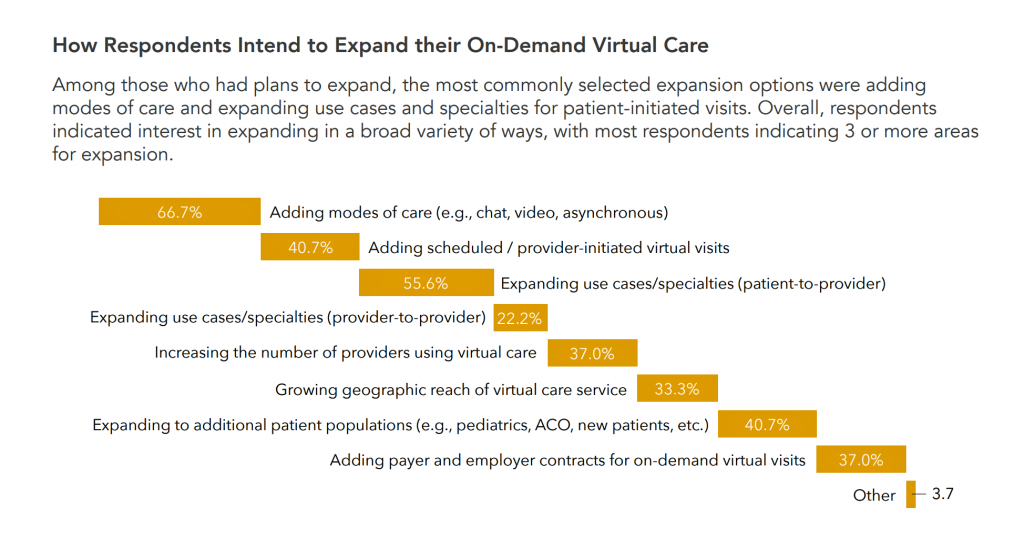Just as we experienced “e-business” departments blurring into ecommerce and everyday business processes, so is “telehealth” morphing into, simply, health care delivery as one of many channels and platforms.
 Telehealth and virtual care are key education topics and exhibitor presences at HIMSS19.
Telehealth and virtual care are key education topics and exhibitor presences at HIMSS19.
Several factors underpin the adoption of telehealth in 2019:
- Consumers’ demand for accessible, lower-cost health care services as people face greater financial responsibility for paying the medical bill (via high-deductible health plans and greater out-of-pocket costs for co-payments)
- Some consumers’ lacking or losing health insurance as ACA coverage eroded in the past two years, resulting in these patients having to self-insure and price-shop for health care services (see my post on the Gallup Poll here on Health Populi)
- Most employers’ adopting telehealth as a covered employee benefit
- Health plans covering telehealth, nudging members toward lower-cost settings for less-acute conditions, and
- Telehealth vendors are collaborating with pharmacies and other retail health sites to scale offerings in communities visible to consumers to help virtual care become more accessible and “discoverable.”
 Nearly all health care providers plan to expand existing on-demand virtual care services, with 6 in 10 of them planning to do so in the first half of 2019, Zipnosis learned in a benchmarking survey that polled 56 organizations operating in all 50 U.S. states.
Nearly all health care providers plan to expand existing on-demand virtual care services, with 6 in 10 of them planning to do so in the first half of 2019, Zipnosis learned in a benchmarking survey that polled 56 organizations operating in all 50 U.S. states.
Of those already offering virtual care services, about 50% have been operating for under 3 years, and one-third, over five years.
To reach patients where they live, work and play, most providers expanding telehealth plan to add different modes of care such as chat, video, and asynchronous communication between clinicians and consumers, shown in the horizontal bar chart. Over half will also add access to physician specialists. These program expansions are value-addes to the basic telehealth value proposition, allowing providers to tailor the telehealth program to a targeted patient population based on consumers’ values, medical conditions, and media/communications preferences.
 Telehealth providers have varying program objectives: the top ranking goals are to remove patients’ geographic access to care, enhance patient experience through convenient care options, and to enhance market position to offer innovative care delivery. A fourth goal, for about one-third of providers, is to reduce the cost of care for risk-based population by siting care at lower-cost sites.
Telehealth providers have varying program objectives: the top ranking goals are to remove patients’ geographic access to care, enhance patient experience through convenient care options, and to enhance market position to offer innovative care delivery. A fourth goal, for about one-third of providers, is to reduce the cost of care for risk-based population by siting care at lower-cost sites.
The “planets” chart illustrates health providers’ perceived areas of virtual care opportunity gleaned from the Zipnosis survey. Behavioral health and mental health features most prominently, sought by nearly 40% of providers. Addressing chronic disease was cited by 17% of providers, followed by follow-up care and oncology.
Health Populi’s Hot Points: My HIMSS19 panel on digital traction in consumerization in healthcare will focus on the case of telehealth featuring leaders from Walgreens, Cleveland Clinic, and Heal. Each of these organizations “do” telehealth in very different ways. We should consider telehealth through the consumer’s retail omnichannel lens, where patients-as-consumers-as-payors now look at health care as other life work-flows.
 On that point, I’ll conclude with the story of Ro as in “Zero,” a consumer-facing health service designed to help smokers quit tobacco. The company built its own physician EMR, pharmacy software, and a pharmacy distribution center which already supports its first company, Roman (which deals with men’s health). Ro see’s itself as a “full stack” health care company, from diagnosis, prescription, treatment delivery all organized on one platform.
On that point, I’ll conclude with the story of Ro as in “Zero,” a consumer-facing health service designed to help smokers quit tobacco. The company built its own physician EMR, pharmacy software, and a pharmacy distribution center which already supports its first company, Roman (which deals with men’s health). Ro see’s itself as a “full stack” health care company, from diagnosis, prescription, treatment delivery all organized on one platform.
The company’s strategy is articulated on its website: “We promised to make the complicated straightforward. The expensive affordable. And the frustrating delightful.”
This is the goal of UX and service design in health care, long overdue in the industry. Zero and Roman are also part of telehealth. Ro will expand in women’s health in 2019.
The legacy health care system be forwarned: virtual health and telehealth are health care. Patients, as consumers and payors, are ready and waiting for you.
The post Telehealth and Virtual Care Are Melting Into “Just” Health Care at HIMSS19 appeared first on HealthPopuli.com.
Telehealth and Virtual Care Are Melting Into “Just” Health Care at HIMSS19 posted first on http://dentistfortworth.blogspot.com
No comments:
Post a Comment